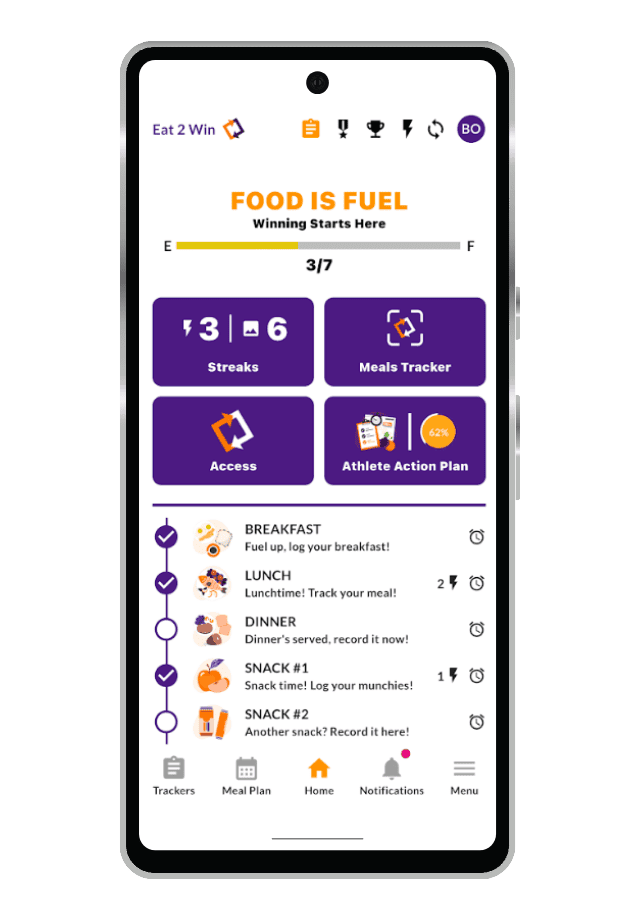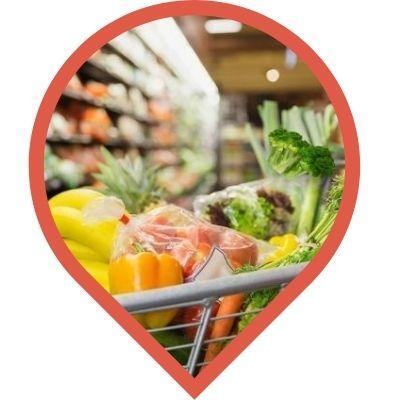
Listen to the DEEP DIVE
- Athlete-s Guide to Smart Grocery Shopping.wav00:00
Before we get to the grocery store game plan, it’s important to point out that you should have a plan of attack.
- Know what’s in your cupboards and what you need/ don’t need
- Brainstorm what do you need for meals/snacks/fuel for the week
- Make a list (even better if you visually “walk through” the grocery store, checking off the sections listed below for a high-performance grocery list)
What’s a high-performance grocery list?
When you go to the store, think of your grocery cart like an “Athlete Plate.” We want you to have quality protein, energy-boosting carbs, healthy fats, and COLOR! If you’re lacking in one area, brainstorm some performance foods you might be missing and write them in. When you make a list for the grocery store-- and before you check out-- give your list (or cart) a “cart check” so you know you’re leaving the store ready to attack the week ahead.
Visualize a Walk-Thru at the Grocery Store
Think about the importance and benefits of visualizing success in a big game, match, or race. Mental preparation is key. Now, translate this line of thinking to the grocery store! Having a mapped out game plan is the first step to success. When you get to your grocery store, where do you typically walk in? For most, it’s the produce section but every store layout is a little different. For this walk-through, we are going to prioritize produce and begin in this section.
Next, “walk the perimeter” of the grocery store and make note of what sections you pass through. “Shop the perimeter” is a common tip when it comes to grocery shopping because you hit your more natural, less-processed foods. Additionally, you’ll be hitting your major food groups to help your body fuel and recover, while maximizing nutrients and freshness. For an athlete, however, there can be some very versatile food items in the aisles, so it’s not that you should avoid the middle aisles. But rather, you should have a PLAN for the middle aisles so you don’t wind up with a cart full of kids’ cereal and chips… Shop with intention.
Grocery Store Game Plan:
Produce Section:
Fruits and vegetables are full of healthful nutrients that are critical for athletes, but they can be expensive. When shopping in the produce section of the grocery store, it is important to be aware of which fruits and vegetables are in season. These options will be lower in price and taste better – so take advantage! Check out a list of seasonal fruits and vegetables here. Also, watch for special produce sales to help you save even more.
- PRO TIP: Choose maybe 3-5 fresh fruits and vegetables for the week but be flexible-- maybe you write down “green vegetable” and decide when you get there based on what looks good. You can also get some fresh/ some frozen fruits and vegetables to save money (and for longer shelf life).
Bread Aisle:
Athletes should buy 100% whole wheat, or 100% whole grain, bread whenever possible. Be careful, though, some companies will try to trick you. Breads that appear brown or say “whole grain” or “wheat” may still be made with refined grains. Make sure the bread that you are buying is 100% whole wheat by checking the ingredient list. Look for “whole grain” or “whole wheat” and avoid the “enriched” wheat flour. Look at the Athlete’s Grocery Shopping List from MSD for a list of suggested brands to purchase.
- PRO TIP: Bread is a versatile food item for the week. Remember sandwiches can come in clutch during busy days or weeks, so plan them as fuel between classes, after school/ before practice, or for a long car ride home after practice. Deli sandwiches are great carb + protein recovery! Just pack with a cooler.
Meat and Seafood:
These items can be expensive, which makes looking deals and specials important. Specials can often be found ahead of time by looking in the grocery store’s flyers or online – so do your research before shopping! When purchasing meats, make sure they are the leanest cut or ground beef that is 90/10 or leaner. If you find a particularly good deal, buy extra and freeze what you don’t need for later – this will save you money in the long run. The leanest cuts of beef can be found here.
- PRO TIP: Don’t overlook the meat/seafood options in the aisles! Canned tuna pouches are a great protein option, as well as jerky. These are some shelf-stable winners to keep on hand in your pantry!
Dairy:
Low-fat and fat-free dairy products are important sources of calcium and protein for athletes. If you choose to buy diary alternatives, be sure to purchase ones that provide adequate protein, calcium, and vitamins A and. D. While soymilk is a good source of protein, almond and coconut milk typically are not. When choosing yogurts at the grocery store, try adding Greek yogurt to your cart. There are often deals on Greek yogurt, and buying a larger container, rather than multiple single-serving containers, will usually save you money.
- PRO TIP: Greek yogurt can have up to twice the amount of protein when compared to typical yogurt, which makes it a great post-workout snack for athletes.
Frozen Section:
When shopping in the frozen section of the grocery store, go right to the frozen fruits and vegetables. These are picked at their peak of ripeness and frozen right away – making them just as nutritious as fresh fruits and vegetables. With that being said, it’s important to purchase frozen fruits with no added sugar and frozen vegetables without creamy sauces or high sodium seasonings. Frozen fruits and vegetables can be a good money-saving choice when you want produce that is not in season. Also, keep in mind: Frozen meals can be convenient, but they are often highly processed and can be expensive. If you start planning your meals ahead of time, and making enough for leftovers, you will not have to rely on buying frozen meals. This will save you both time and money.
- PRO TIP: Frozen fruit blends GREAT in smoothies! Keep a stock of frozen fruit in your freezer, and if your fresh fruit or spinach looks like it’s about to go bad, through it in a freezer bag and store it for smoothies.
Cereal Aisle:
Just as with the bread aisle, it is important to stick with whole grain options. There is a new consideration in the cereal aisle, though – the sugar content. Luckily, there are plenty of healthy, and tasty, cereals available that are low in sugar. As a general rule, choose cereals with less than 25% of their calories coming from sugar. There are often coupons available for brand-name cereals, but if you are looking to save money without using coupons, you can opt to buy the generic brand.
- PRO TIP: Generic brands often contain the same ingredients, have the same nutritional value, and are much less expensive than the brand-name items.
Canned Food Aisle:
Canned foods tend to get looked down upon, but they can be good options - especially for athletes on a tight budget. Stores often have great deals on canned foods, and these items have a long shelf life - meaning you can buy a large amount when they’re cheap, and keep them for later. When buying canned fruits, make sure the fruit is packaged in 100% fruit juice – not syrup. When purchasing canned vegetables, look for options that are low in sodium, or have no salt added.
- PRO TIP: Chili can be a life-saver on busy weeks or if you’re trying to save some money-- and majority of the ingredients come from shelf-stable canned foods. Keep low-sodium beans, diced tomatoes, tomato paste, chicken broth and other common items on stock for when you’re in a bind!
Bulk Food Section:
This section of the grocery store is great for purchasing items such as nuts, trail mix, whole grains, flours, and dried fruits. Buying these items here is often less expensive than buying them in other areas of the store. This is because you are not paying for any pre-packaging, and you can get the exact amount that you need. The grocery store may also have specials on various bulk foods – so if one of your favorite items goes on sale, buy extra!
- PRO TIP: Mix and match your own trail mix using individual bulk items- and make a big bag of it when traveling! These are full of healthy fats and nutrients to keep your energy and focus.
Condiment and Sauce Aisle:
This can be a tricky section of the grocery store, since condiments and sauces have a wide range of fat and calorie contents. When buying condiments, try to stick with low fat options, and limit creamy dressing (such as ranch) as much as possible. Check out the Athlete’s Grocery Shopping List for more information on healthy condiment options.
- PRO TIP: When picking nut butters, try to buy all natural varieties to avoid the trans fats that may be found in the processed options. To see if a spread contains trans fat, check the ingredient list – if it includes hydrogenated oils or partially hydrogenated oils, then it includes trans fats, and you should avoid buying it.
Fruit Juice and Beverage Aisle:
100% fruit juice is a healthy option, but some companies may try to trick you. If you buy a juice, or fruit “beverage”, that is not labeled 100% fruit juice, it is likely more similar to sugar water or soda than juice. Bottle waters and sports drinks may also be found here and can help with your fluid needs as an athlete- keep in mind though, utilize sports drinks with sports and not just mindlessly drinking sugar!
- PRO TIP: While 100% juice is a good option, if you want to get all of the benefits of fruit, it is best to eat the whole fruit. This way, you are also getting the added benefits of fiber, which is not provided in juice.
Snack Food Aisle:
Snack foods, such as chips, pop tarts, and candy, are not the best options for athletes looking to perform their best. Start thinking of snacks as opportunities to consume even more healthy foods to fuel your body. With that being said, avoiding the snack foods aisle of the grocery store is your best option.
- PRO TIP: Tasty snacks can be made from food purchased in the other areas of the grocery store. Some options include: Hummus with vegetables, fruit with nut butter or low fat string cheese, or Greek yogurt.
Eat 2 Win Nutrition App
Fuel the Champion Within
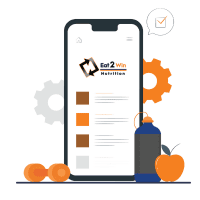
Trackers
Stay on target with cutting-edge trackers that monitor every step of your journey, ensuring you never miss a beat.
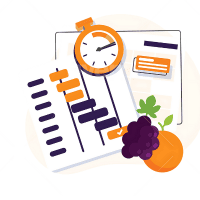
Meal Plan Guides
Simplify your nutrition with easy-to-follow, personalized meal plans that fuel your performance.
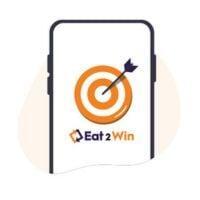
Gamification
Stay motivated and engaged by earning rewards and climbing leaderboards as you hit your fitness and nutrition goals.

Access a Sports Dietitian
Get expert guidance and personalized support from a certified Sports Dietitian whenever you need it.
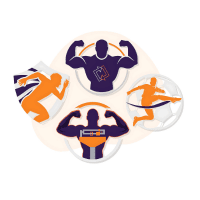
Personalized Programs
Unlock your full potential with personalized programs meticulously crafted to match your unique lifestyle and fitness aspirations.

